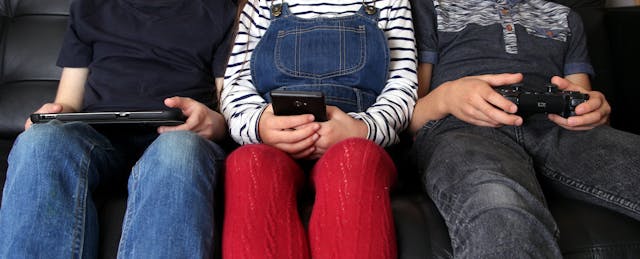When the American Academy of Pediatrics released its most recent set of guidelines for children’s media use, much of the list reflected the organization’s long-standing recommendations of limiting digital play time for toddlers to maintain a “healthy media diet.” However, one change particularly stood out: The academy no longer suggests that children under two years old avoid screen time entirely. Exceptions, the group stated, could be made for video chatting services like Facetime or Skype.
The new guidelines not only recognize the increasing ubiquity of these apps and their use in connecting classrooms and families, but also that all screen time is not created equal.
It’s an important idea, and one that should be considered as educators and parents go about creating their own guidelines and practices for children’s screen use. Digital devices are tools. They are not inherently good or bad. Rather than setting time limits on screen time, we should set limits on certain kinds of screen-based activities.
Think of devices and their uses on a spectrum. On one end sit activities that are 100 percent passive, like watching a movie. On the other end sit activities that are much more active, like Skype, Facetime, or other communication tools. In the middle, we have software, games and apps of varying educational quality.
While telling a child that he or she is limited to 30 minutes of screen time may have worked for our generation—whose only screens were likely televisions after school—the rule makes far less sense with today’s learners.

We’re already seeing the way that the changing nature of technology is creating different relationships between children and their screens. In a study published last month, researchers from the Oxford Internet Institute and Cardiff University found that there was no correlation between parents’ adherence to screen time guidance and their children’s wellbeing. Things like caregiver attachment, emotional resilience and curiosity remained consistent between the groups that stuck to the recommended maximum of two hours of screen time a day and the groups that exceeded it.
This should make it clear: When children are negatively affected by technology, it’s not just that they are using screens, but the way they’re using screens.
Of course, watching a YouTube clip is very different than programming a robot to shoot a basketball. Wii Fit moved video gaming from a stationary activity to a more active one, and Pokemon Go took this one step further, requiring players to walk outside to “catch” their creatures. Facetime and Skype allow classrooms, friends and families to interact with one another from across the globe.
As a former classroom teacher and current industry professional, I follow media research closely. There are many sensationalized headlines about the ills of screen time. Some are well-founded, like the recent academic study on excessive social media use. However, not all screen use is equal. There is tremendous opportunity for students using screened devices in the right context and with the right content to achieve amazing learning benefits. Devices allow students to collaborate on digital projects, connect and exchange ideas with other learners across the globe, or manipulate the physical world by programming robots to act out scenes and navigate obstacle courses. Through such examples, we learn a screen can be an appropriate means to an end, empowering student learning along the way.
These learning benefits even go beyond teaching students how to program and code, as Frank Tappen, a coach of an all-girls robotics team, was surprised to learn earlier this year. The team took first place at a robotics competition earlier this year. He explained to USA Today that “while solving this year’s missions, the girls learned invaluable, lifelong skills about time management, group collaboration and contributing to their community.”
Educators and parents want what’s best for children. When we think of screen time, we often envision children sitting on a couch, slack-jawed and eyes glazed, so passive you can barely tell they’re breathing. But just like so many other things when it comes to children, context matters. Not all screen time turns kids into zombies. Setting rules and boundaries is great and important, but we need to make sure they’re the right kinds of boundaries.
The option does not have to be between simply using a screen and not using a screen. Do we really want to force a child to pick between 30 minutes of watching videos online or 30 minutes playing an educational game with a friend? Or between playing her favorite video game and using a block-based coding app to conduct a robot parade? Those sorts of restrictions are limiting in ways beyond simple time constraints. They can limit connections and even personal growth.
Screens can play a positive role in the development of a child. We just have to make sure it’s the right kind of screen time.


